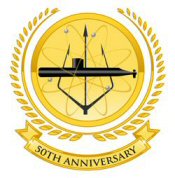
1962

|
USS SARGO (SSN 583)
1962 |

Click on the pictures to enlarge!
|
In January and Februrary USS SARGO conducted local operations and an upkeep in the Pearl Harbor area.
On 22 February USS SARGO deployed for an extended training exercise in the Pacific. After returning in May the USS SARGO conducted local operations and conducted a pre-overhaul availability through July of 1962. On 30 Jun 1962 the ship was awarded the Battle Efficiency “E” award for the second consecutive year. This award was for the period July 1961 to June 1962. The “E” was won in competition with submarines in Submarine Division SEVENTY-ONE. On July 28, 1962 the USS SARGO entered the Pearl Harbor Naval Shipyard for overhaul and refueling. USS SARGO was the first nuclear powered submarine to undergo refueling at Pearl Harbor. |
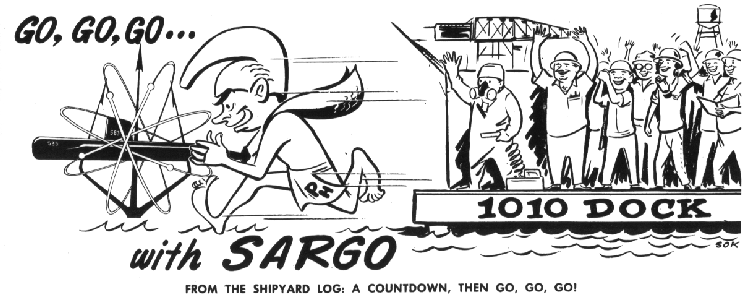 Courtesy Paul Early
Courtesy Paul Early
|
| Pearl Harbor Naval Shipyard Logo for the USS Sargo Refueling Overhaul. |
| From a 04 Aug 1962 article in the local PATROL magazine: |
|
Chief Engineman Kay Charbonneau of SARGO has retired after 20 years of naval service and has been employed by the Pearl
Harbor Shipyard.
He was piped-off his boat last month after receiving commendations and a plaque from Lieutenant Commander Paul J. Early, his CO, during his meritorious services. The chief is a former crew member of SEADOG (1948-50), PICKEREL (1950-53), TIRU (1956-60), and SARGO (1960-62). Chief Charbonneau has been employed at the shipyard as a Machinist Marine in Shop 38 (Outside Machine Shop). He and his wife, Mary, and their children live at 4355 Keaka Drive. |
| On 17 Nov 1962, LCDR Paul J. Early, the Commanding Officer was awarded the Legion of Merit and SARGO received its second Navy Unit Commendation. |
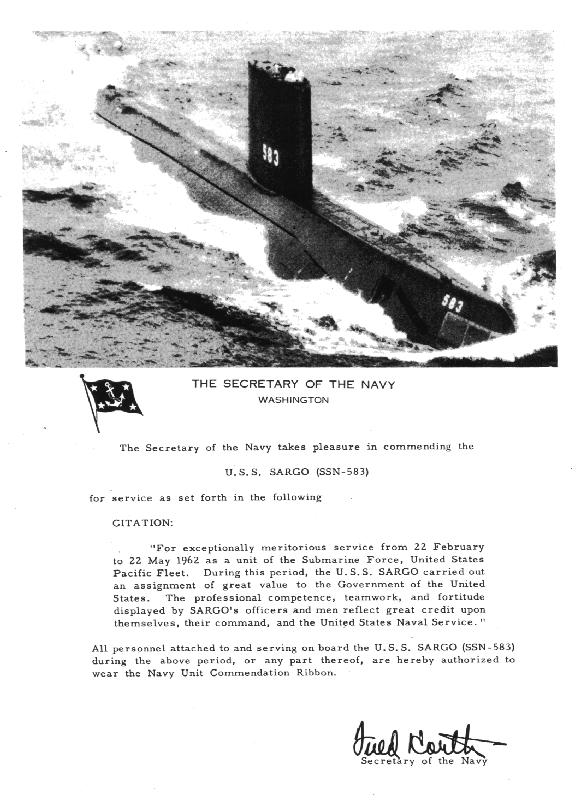
|
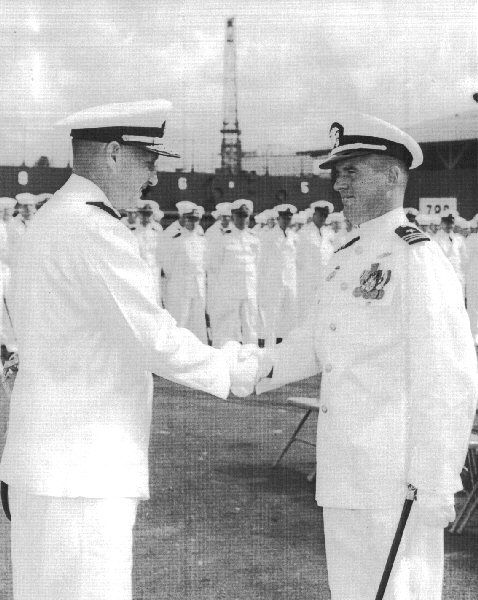 Courtesy Paul Early
Courtesy Paul Early
|
|
| RADM B. Clarey presenting NUC |
| The Citation read: |
| "For exceptionally meritorious service from 22 February to 22 May 1962 as a unit of the Submarine Force, United States Pacific Fleet. During this period, U.S.S. SARGO carried out an assignment of great value to the Government of the United States. The professional competence, teamwork, and fortitude displayed by SARGO's officers and men reflect great credit upon themselves, their command, and the United States Naval Service." |
|
In addition to the Naval Unit Commendation the USS SARGO was also awarded the Marjorie Sterrett Battleship Fund Award on
28 Sep 1962. The award was presented to “promote welfare and morale of the enlisted men of your ship’s company, in
accordance with the instructions issued by the Secretary of the Navy on 18 June 1953.” The cash award of $282.72 went to
a ship’s party.
The Marjorie Sterrett Battleship Fund Award is presented annually by the U.S. Navy's Chief of Naval Operations to one ship in the U.S. Atlantic Fleet and one in the U.S. Pacific Fleet. Generally the recipient is the ship with the highest score in the fleet's annual competitions for Battle Efficiency Awards, and is therefore often thought of as the fleet's most battle-ready ship. This isn't strictly correct, because it has been the policy to rotate eligibility for the award annually among the various type commands (aircraft carriers, submarines, amphibious ships, etc.). The award includes a small monetary stipend (about $500 in 2004). Commanding officers receiving the award must put the money into the ship's recreation fund, where it can be spent on athletic equipment, prizes for athletic or marksmanship competitions, recreation room furniture, dances, parties, and similar recreational activities. The Marjorie Sterrett Battleship Fund was established in 1917 by the Tribune Association. It was initiated by a contribution which accompanied the following letter, printed on February 4, 1916: |
|
To the Editor of the New York Tribune "Dear Sir: "I read in your paper every morning a lot about preparedness. My
grandpa and my great grandpa were soldiers. If I was a boy I would be a soldier, too, but I am not, so I want to do what I
can to help. Mama gives me a dime every week for helping her. I am sending you this week's dime to help build a battleship
for Uncle Sam. I know a lot of other kids would give their errand money if you would start a fund. I am 13 years old, and
go to Public School No. 9, Brooklyn.
Truly Yours, I am a true blue American and I want to see Uncle Sam prepared to lick all creation like John Paul Jones did. P.S.—Please call the battleship America. |
|
The letter was written during the buildup to America's entry into World War I, and it generated a huge response. Former
president Theodore Roosevelt responded immediately with a handwritten letter and a dollar contribution; within a few days
he met with Marjorie in Manhattan. The Tribune printed the name of every contributor, and newspapers across the country
reprinted Marjorie's letter and received additional donations. Grammarians criticized her use of the word "like" as a
conjunction, but the rest of the world adored her and made her a teenaged celebrity. Ultimately 200,000 dimes were
collected, each typically in the name of a child or a contributor's yet-to-be born grandchild. The money was offered to
the Navy, but Secretary Josephus Daniels at first rejected it, citing legal prohibitions. A law was soon enacted allowing
the Navy Department to accept the money, and by early 1917 the $20,000 had been transferred to the government. Prior to
World War II, income from the fund was used to pay prizes annually to turret and gun crews making the highest scores in
short-range battle practice, and to submarine crews making the highest scores in torpedo firing. Since the end of World
War II, the Navy has emphasized readiness and fitness of the ship rather than competition between individual departments.
1948 was the first post-World War II year in which awards were made. Awards were discontinued in 1951 due to the Korean War, and were not reinstated until 1958. The USS SARGO remained in Pearl Harbor Naval Shipyard for the rest of the year undergoing overhaul and refueling. |

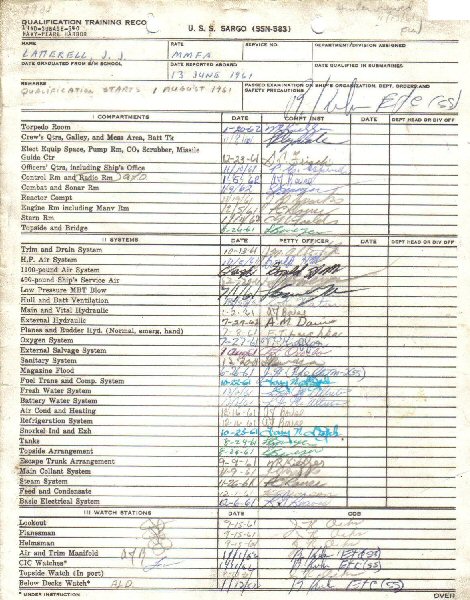 Courtesy James Latterell
Courtesy James Latterell
|
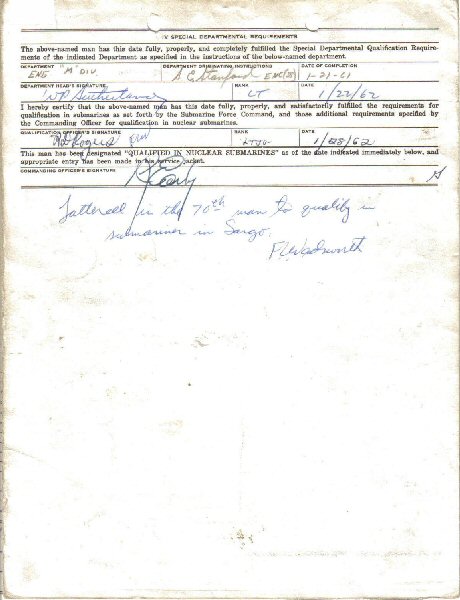 Courtesy James Latterell
Courtesy James Latterell
|
|
| James Latterell's Submarine Qualification Card | James Latterell's Submarine Qualification Card |
